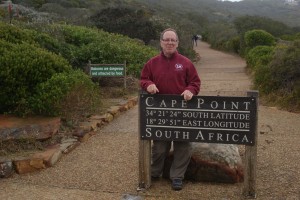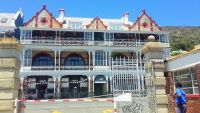
We’re leaving Cape Town in the morning for “Africa.” I’m sure it will be a shock to leave this first world ambience, which characterizes most of the Cape Town area we explored yesterday (the Consulate is in a swank neighborhood) and along the coast today. We did the “Cape tour” which took us around the Cape of Good Hope (baptized originally, as I mentioned, as the Cape of Storms by discoverer Diaz, but renamed “Good Hope” by a shrewder King). The highlights are probably best captured in pictures (which I’ll send when I get a chance), but here’s my attempt to verbalize them:
The ride around the Cape peninsula is a study in wealth expressed primarily in architecture—beautiful homes fronting the Atlantic, in towns like Simon’s Town (the headquarters of the British South Atlantic Fleet until 1957, and a naval base today); a “cheap home” cost around $500,000. The area has attracted a lot of Europeans because of the low relative price for the high relative value—gorgeous scenery.
The stop at the Cape itself. Though it’s not where the two oceans (Indian and Atlantic) meet, the Cape is where most people think they meet (it’s at another cape not more than 100 meters away). The setting is stunning, with beautiful beaches and cliffs—and about a mile and a half hike for the adventurous (including me) from one of the beaches to the aptly named “Two Oceans Restaurant,” which served some delicious seafood. I enjoyed the Cape Lobster, partly because someone told me it was less than an hour off the boat.
 We also had another stop at a penguin colony, in a nicer setting than Betty Bay, where I had been greeted by my little friends in tuxedos. This stop, part of the Table Mountain Marine Reserve, started with two pairs in 1982, and with encouragement (numbered fiberglass burrows), some food supplements, and changes in legislation and attitude in favor of environment, the colony is up to 2000. I wish I could swim as well as they do—about 5 miles an hour—but they look really graceful in search of food. Tis said they will feed within 6 miles of the colony.
We also had another stop at a penguin colony, in a nicer setting than Betty Bay, where I had been greeted by my little friends in tuxedos. This stop, part of the Table Mountain Marine Reserve, started with two pairs in 1982, and with encouragement (numbered fiberglass burrows), some food supplements, and changes in legislation and attitude in favor of environment, the colony is up to 2000. I wish I could swim as well as they do—about 5 miles an hour—but they look really graceful in search of food. Tis said they will feed within 6 miles of the colony.

Finally, I did a little exploration of Simon’s Town. There are some old buildings and a cute waterfront that is renovated. There was one marker I hadn’t seen before though—a monument to the diverse peoples of Simon’s Town who lived together in peace until 1967. We weren’t there long enough to piece everything together (there’s a 1923 mosque in the town), but I suspect that during apartheid, the non-whites were forcibly evicted—a sad reminder of the history that still haunts South Africa.
We leave at 4 am for Zambia, in what I am sure will not be a “third world country in a first world setting,” as Consul General/Ambassador Taylor described Cape Town yesterday.
Goodnight. Get ready for a Memorial Day weekend.